Fava Beans, the Biggest of the Beans
Vicia faba
Family: Fabaceae
COOL SEASON LEGUME
TThe plump, thick bean pods grow on seasonal plants that can reach up to almost two meters in height and are one of the oldest cultivated plants recorded among ancient civilizations. Fava beans are also known as Broad beans, Windsor beans, and sometimes Field beans and were historically used as a ground cover crop. The Fava plant is known for its ability to nurture soils with added nutrients such as nitrogen and was helpful to farmers to control weeds. For many years, Fava beans were seen more as a rotational crop and livestock feed rather than a crop for human consumption, but over time, farmers began to turn to the beans as an important protein source. In the modern-day, there are many different varieties of Fava beans, and chefs view the early, cool-season legumes as a sign of spring. Fava beans are only available for a limited time and offer a bright, grassy flavor to spring dishes.
History
Fava beans are one of the oldest domesticated bean varieties and have been cultivated since ancient times. Experts found archeological remains in Israel and believe these findings can be traced back as early as the Neolithic period, from 6800 to 6500 BCE. Fava beans were later introduced from the Middle East into the Mediterranean in the early ages, eventually traveling along trade routes into Northern Africa and Southwestern Asia. The beans were prevalent in Ancient Egyptian, Greek, and Roman civilizations, where they were used for religious rituals, livestock feed, and as a source of protein. Today Fava beans are found worldwide and are cultivated in temperate regions with cool seasons. The beans are still used in crop rotations for farming, animal feed, and human consumption and are sold through local markets in the spring in North America, South America, Europe, Asia, Africa, and Australia.
USES
Fava beans have a fresh, sweet, and subtly bitter flavor well-suited for both raw and cooked applications. Young beans are primarily eaten fresh as they bear a more tender texture, but mature beans will become starchier and are only edible once cooked. Mature Fava beans also require some preparation before they can be consumed. The pods can be unzipped and opened, removing the beans, and the beans should be blanched and then shocked in cold water to remove the thin, protective coating. Once prepared, Fava beans can be boiled, fried, roasted, stewed, steamed, or mashed. The beans can be tossed into green salads, dressed in oils and herbs as a side dish, stirred into soups, or pureed into sauces such as pesto, dips, and spreads. Fava beans can also be used as fillings for fritters, mixed into grain bowls, combined into pasta, or incorporated into dishes featuring other springtime ingredients. Beyond fresh beans, Fava beans are often dried for extended use, and once reconstituted and cooked, they will bear a soft, chewy consistency reminiscent of chickpeas. Fava beans pair well with artichokes, asparagus, peas, spinach, morel mushrooms, meats such as bacon, lamb, and poultry, seafood, chicory, lentils, leeks, citrus, and cream or wine-based sauces. Fresh, unshelled Fava beans will keep up to 10 days when stored in a container in the refrigerator. Once shelled, the beans should be immediately consumed for the best quality and flavor but will keep up to 3 days in the fridge. Fava beans can also be frozen for up to one month.
In the Sichuan cuisine of China, broad beans are combined with soybeans and chili peppers to produce a spicy fermented bean paste called doubanjiang.
17 Chefs on their Favorite Ways to Cook Fava Beans
PRESERVATION
Fava beans are often dried and stored in a cool, dry place in the house. Freezing is another common way to preserve fava beans. (remove the husk and outer skin, wash them, dry them, and then put them in freezer bags). You can also make them into fermented pastes (like doubanjiang).
GROWING
SEASON & PLANTING
Fava beans are best planted as soon as September or October (and can be planted throughout the cool season) and grown as a cool season crop.
SOIL & NUTRITION
Plant in amended garden soil. Since fava beans are legume, they don’t need to be fertilized (they have relationships with mycorrhizae which help them utilize nitrogen in the air).
TEMPERATURE & SUN EXPOSURE
Fava beans are cool season crops and can handle temperatures as low as 10-15°F.
WATER
Provide steady, regular water, as usually found in a garden bed.
HARVESTING
The pods are ready to pick when they feel full and plump, and are green, thick, and glossy. If the pods feel spongy, they need more time to mature. They can be consumed green or allowed to dry.
WILDLIFE
There are a few insects that can eat holes in the leaves of fava beans, but nothing too serious.
INVASIVENESS
Fava beans do not seem to escape cultivation in our region.

